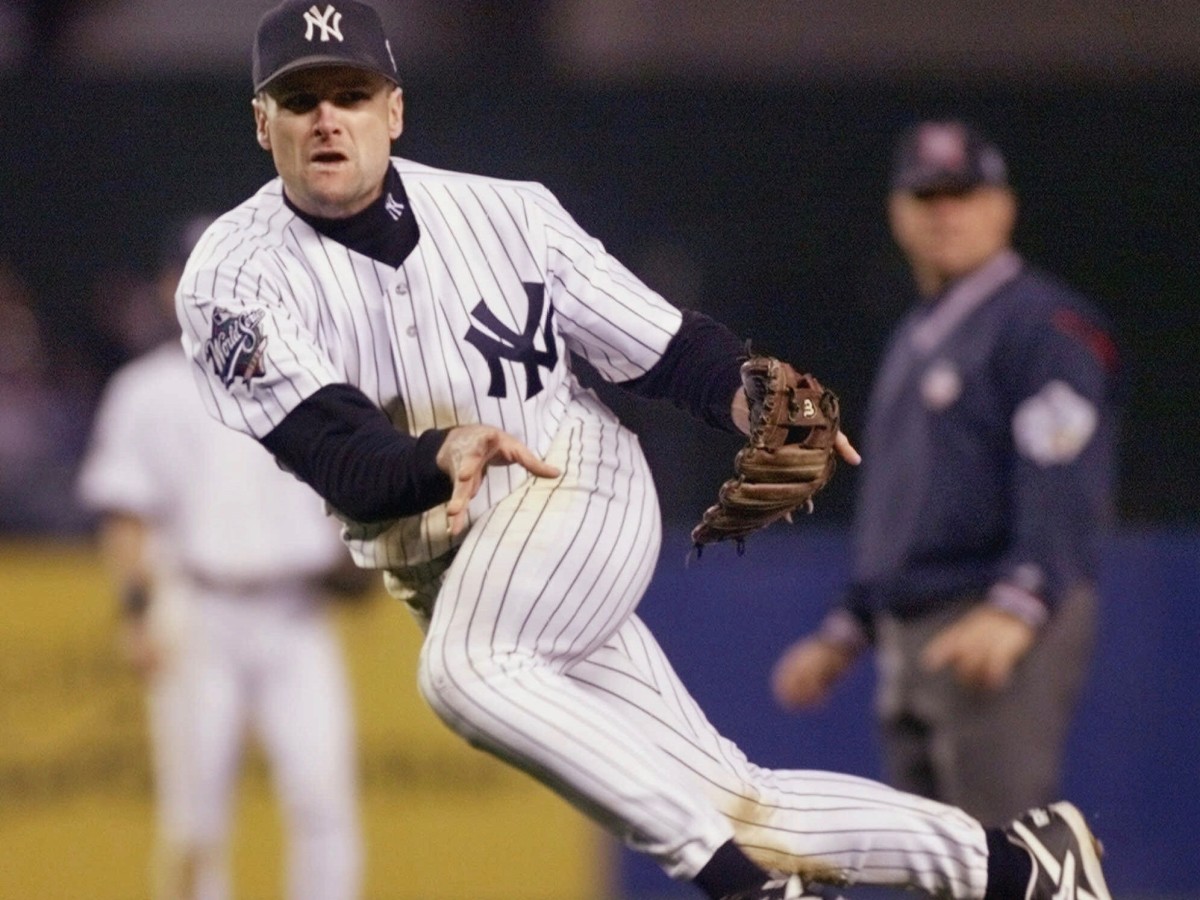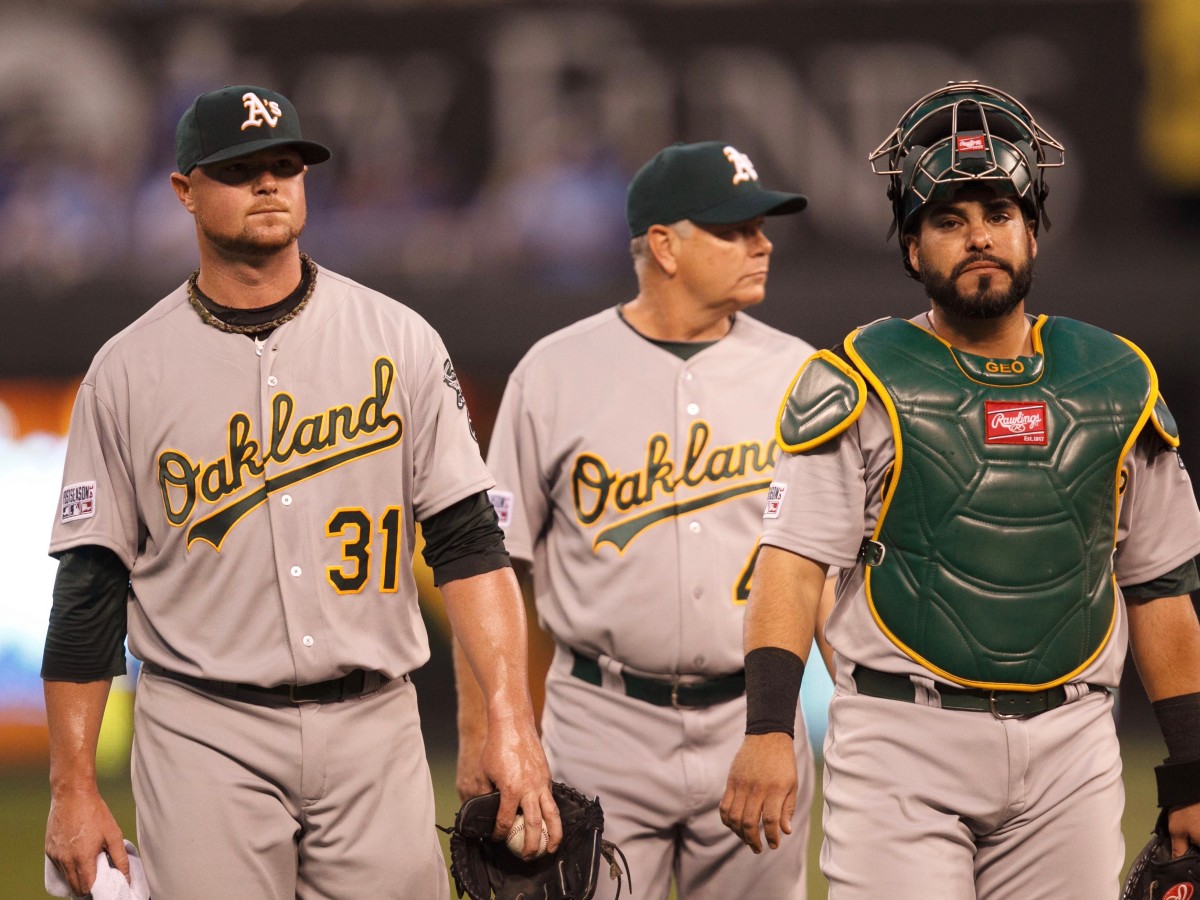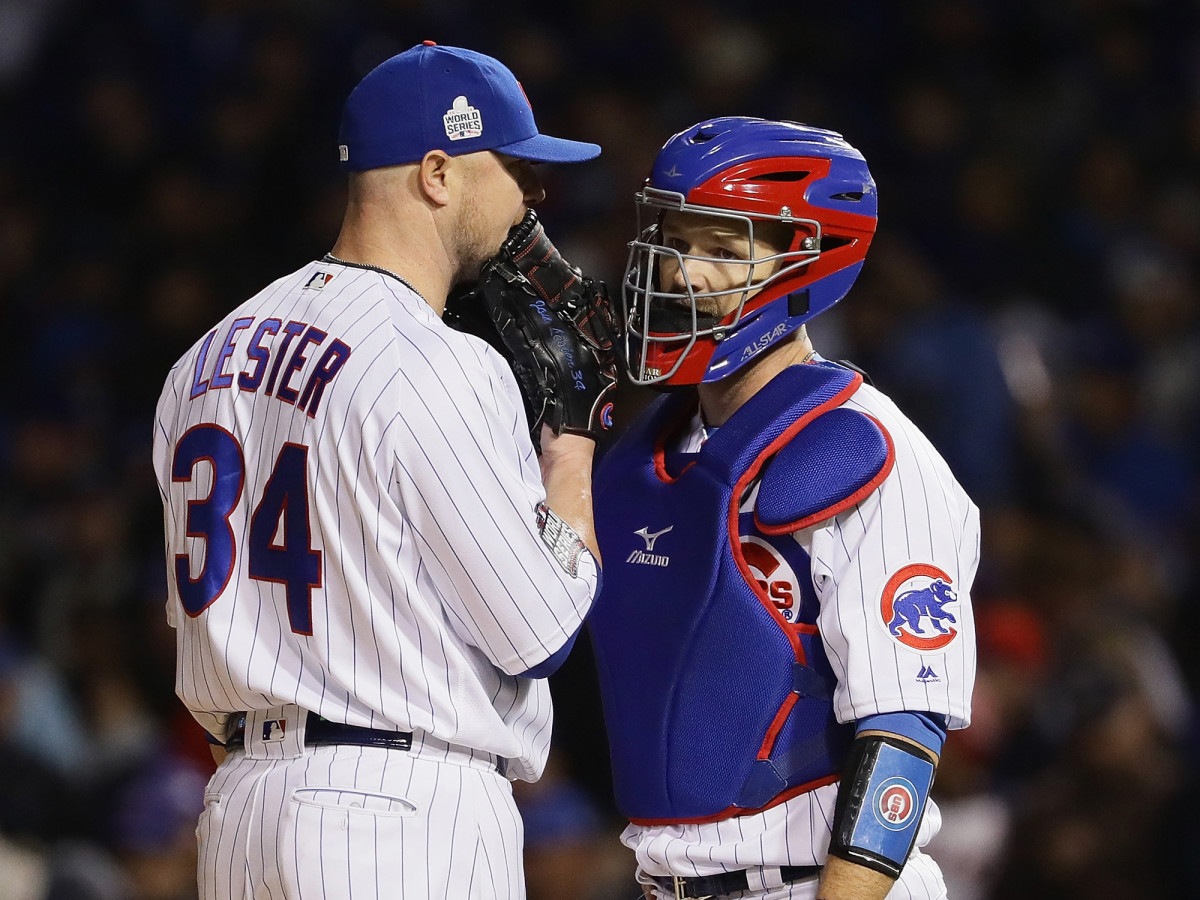Jon Lester didn't just beat the yips, he improved once the secret was out

From his couch in Melbourne, Fla., Tim Wakefield prepared to watch disaster unfold in front of 40 million people. He recognized the danger the instant Cubs manager Joe Maddon signaled for Jon Lester to come in with a man on first base in Game 7 of the 2016 World Series. Wakefield, Lester’s longtime teammate, gaped at the TV. What was Maddon doing?
On a barstool at his eponymous restaurant in Stamford, Conn., Bobby Valentine glanced up from his Stella Artois and felt something in him tighten, a feeling he remembered from a season as Lester’s manager. Wow, Valentine thought. This might be when it finally happens.
In their living room in Trophy Club, Tex., 16-year-old Ty Bogar turned to his father, Tim, Lester’s former bench coach. “Do you think they’re gonna run on him, Dad?” he asked. Tim’s mind raced: God, I hope not. The last thing Cubs fans need is another person to blame. Jon’s too good a pitcher for it to end like this. “I think they’re gonna try,” he told Ty.
In Cleveland, Lester and catcher David Ross approached the diamond from opposite directions: Lester from the bullpen, Ross the dugout. Both were well aware that Lester suffered from a disorder that threatened to spoil his night and Chicago’s World Series hopes. With the help of half a dozen coaches and a handful of teammates, he had spent the better part of a decade searching for a cure. But when they met on the field that night, Lester and Ross did not discuss the problem. They never do.
*****
Jon Lester cannot throw to first base.
This seems ridiculous. He can paint the black with the game’s fiercest cutter, which heads for the lefthanded batter’s box before making a sharp right turn. He can curl a curveball past a bat, mix and locate his offerings with precision, and make them all look identical coming out of his hand. Lester is one of the best pitchers of his generation. So why can’t he turn 90 degrees to his left and do the same thing he does toward the plate?
Of course, it’s not quite the same. The mound slopes differently toward first. The throw is longer. The target is higher. Lester has less control over the proceedings, either because he’s reacting to an infield dribbler or because he must time a pickoff to trick the runner. And the move is rare enough that each occasion feels notable, an opportunity to screw up anew. He’s entirely alone out there.
MLB Mock Draft 1.0: Should Twins take Brendan McKay or Hunter Greene with No. 1 pick?
Oh, and everyone knows.
“He’s Mona Lisa,” says Valentine. “With a big pimple on her nose.”
But since opponents found out about Lester’s limitation—some slowly, starting in the 2012 season, and the rest very quickly during the ’14 AL Wild Card game—Lester has pitched better than ever. Through ’14, his ERA was 3.58 and he put 11.5 men on base per nine innings. Since then: 2.95 and 9.94. Last year, as the ace of the most scrutinized team in baseball, Lester finished second in NL Cy Young Award voting. It is one of the greatest mental achievements in recent baseball history.
The young pitcher whose catchers once had to visit the mound to settle him down when a borderline call went against him has grown into a veteran who does not just function despite his shortcoming; he excels, in part, because of it. It’s as if he doesn’t understand that the yips are supposed to destroy his career.

Yip is such an innocuous word. It sounds like a hiccup, an affirmation, the noise your Pekingese makes when she wants a bite of your steak. No one knows for sure where the term came from, which seems appropriate, since no one knows for sure where the curse it describes comes from, either. Golfer Tommy Armour is thought to have coined the term half a century ago to refer to the last-second hesitation that inexplicably yanked his putts wide. The yips have afflicted dart throwers, archers, billiards players, cricketers. And baseball players. The most famous victims are Steve Blass, the Pirates righthander who suddenly could not throw a strike starting in 1973; Steve Sax, the Dodgers second baseman who briefly lost the ability to throw to first after an error in ’83; Mackey Sasser, the Mets catcher who was forced to retire when he became unable to get the ball back to the pitcher following a ’91 collision at the plate; Chuck Knoblauch, the Yankees second baseman who had to move to leftfield because, starting in ’98, he could no longer make short infield throws; and Rick Ankiel, the Cardinals phenom who lost the strike zone in 2000 and reinvented himself as an outfielder.
Baseball men go to great lengths to avoid the subject. They shy away from even the word, calling the yips “it” or “the monster” or “the thing.” What if it’s contagious? What if you’re next? It’s as if naming the condition—or even thinking too hard about it—can summon it, the sport’s Voldemort.
There are many guesses about how the yips start. One off-target toss that allowed a run, perhaps. An injury a player didn’t realize he was compensating for. Some trauma in his past. Lester declined, through a representative, to speak for this story; if he knows the cause of his case, he has not shared it with anyone SI interviewed. Kevin Youkilis, Lester’s longtime first baseman with the Red Sox, recalls a pickoff attempt during Game 4 of the 2007 ALCS that darted like that signature cutter; Youkilis was charged with the error, but he’s always wondered if that was the night Lester started to question himself. John Farrell, then Lester’s pitching coach, noticed a growing uneasiness with the throw to first starting in ’09, but never an outright inability to make it. Then-manager Terry Francona’s theory is simple: That after the ’10 season, Lester went home to suburban Atlanta determined to work on his pickoff move and just overdid things.
Whatever happened, he came back in 2011 having lost the feel for it. The Boston brass caught on right away. But Lester was lefthanded, staring at runners from the set position, and anyway, they rarely found themselves in position to go. You can’t steal first, as nearly every person who recounts this tale points out. So the Red Sox just kept calling for pickoffs at his career rate, two or so per start. By September, though, Francona thought he looked truly miserable out there, so they abandoned them altogether.
Please stop asking Curt Schilling for his idiotic takes on Adam Jones, race or anything else
“I didn’t think people were gonna notice,” Francona says.
For the most part, they didn’t. Some teammates didn’t even know until they heard announcers discussing it on TV years later. Advance scouts were aware that Lester rarely threw to bases, but no one aggressively acted on the information. In 2012, Lester attempted five pickoffs. In ’13, six, none after April. In ’14, zero. And yet runners tried to steal on him only about once every 12½ innings, a rate that ranks ninth among the 17 starters who threw at least 600 innings over that period.
Still, people had started to whisper. “Did you hear about that kid in Boston?” someone asked Blass. Base stealers passed the intel to their counterparts on other teams. By the time the A’s traded for Lester at the ’14 deadline, he did not have to warn them. They already knew.
So did Royals first base coach Rusty Kuntz, who met with his hitters before the AL Wild Card Game. We are going to run, he told them. Kansas City swiped three bases against Lester and barely missed a steal of home. As teammates cringed, Lester allowed six runs in 71/3 innings and Oakland lost 9–8.

The secret was out. The Cubs gave him $155 million over six years, and fans waited for runners to gash him. At first they did: The Cardinals ran four times on Opening Day. Three weeks later, Reds centerfielder Billy Hamilton, who set the minor league steals record with 155 in ’12, stole three bases in as many innings. That August, the Brewers tortured Lester with six attempts. In the end, he allowed 44 steals, the most ever by a lefty. Still, he had a 3.34 ERA. The Cubs won 97 games. Ross set the pitching machine to CUTTER and spent the off-season working on his transfer.
And since then … nothing. Well, not nothing: Batters show bunt. Runners take longer leads against him than against any other lefthanded starter. But then they pull back and swing, or lean awkwardly toward first. Lester glares into the opposing dugout. They still run sometimes, but they should be running all the time. Every man who gets on should go on first move. And yet the Dodgers spent much of the 2016 NLCS wandering absurd distances from the bag—at one point second baseman Howie Kendrick was more than a third of the way to third base when Lester released a pitch—but ran only twice in two games.
Rightfielder Josh Reddick, who did not face Lester in that series, seethed. Los Angeles had formulated a plan—get your lead and go—but only the first half of it materialized. Reddick says managers should tell their players, If you get thrown out, I’ll give you 500 bucks! Runners already have a more powerful incentive: the fear of looking stupid. Dancing out to a 20-foot lead is fun, until doubt sets in. You are alone out there. You are very far from first base. This could all be a long con. No major leaguer truly can’t throw to first.
“If he does happen to make that one accurate throw and you’re out, you’re gonna be like, Why did I do this?” says Adrian Gonzalez, once Lester’s first baseman in Boston and now a Dodger. Gonzalez hit 18 home runs last season but was thrown out trying to bunt for a hit against Lester in Game 5 of the NLCS. Lester allowed one run in seven innings. Gonzalez went 0–3.
Opponents trying to get in Lester’s head for the most part just get in their own. Since 2011, Lester’s teams are 8–3 when the other club runs four or more times. His ERA is 3.00 in those starts. Other players speak of him in a tone of baffled admiration. In some ways, this weakness has enhanced his reputation.
The case against a lottery for the MLB draft
Meanwhile, his teammates and coaches have largely left him alone. Valentine, his 2012 manager, didn’t want to suggest to Lester that his skipper didn’t believe in him. Bob McClure, his pitching coach that year, decided that no one was running anyway, so why bother? Even Ross, who became his personal catcher in Boston in ’14 and operated in the same capacity with the Cubs the last two years, has never had a real conversation with Lester about his reluctance to throw to first.
“It’s not like he doesn’t know” he has trouble with it, says Ross. “What am I gonna say? It’d be the same as him giving me hitting advice. I’d tell him to f--- off.”
Well, sure, but in this case, Ross might be able to offer a little more guidance: In High A, he found himself in a similar situation. At a coach’s suggestion, Ross removed a glove tap from his throwing motion and soon became completely unable to throw straight. Some players with the yips describe a baseball that seems to be the size of a golf ball or a basketball in their hand. That wasn’t Ross’s problem. The throws felt good … until they sailed feet away from their targets. At one point, warming up a pitcher in the bullpen, Ross lobbed a baseball into play during a game. He was shaken: What use did the Dodgers have for a 22-year-old glove-first catcher who couldn’t get the ball back to the pitcher?
He experimented with arm slots before finally returning to his original motion—which cleared it up almost immediately. These days he rarely falters.
“That’s what people don’t get,” Ross says. “If you knew what the problem was, you’d fix it.”
Ross overcame his hesitation. But he’s never told Lester about it. “Nah, he doesn’t know the history,” he says, then laughs. “He knows I [threw] him sliders every once in a while.”

Sometimes a teammate will break through the taboo. In 2011, after Gonzalez noticed that Lester’s throws to first were consistently off-target, he pulled his ace aside. Hey, Gonzalez said. When you’re gonna pick over, I don’t care how you throw it. Just keep it in front of me and I’ve got you. Lester nodded.
Gonzalez spent the rest of the season giving his starter occasional pep talks. “You can always just get the hitter out,” he’d remind him after games and between starts.
Lester’s troubles got lost in the carnage of Boston’s historic collapse that season—from nine games up in the wild card race in Sept. 3 to out of the playoffs—but when he reported to spring training in 2012 with no better handle on the problem, the team took action. Bogar, who was in charge of tutoring infielders, reached out early in camp. “What’ve you got on your throws to first base?” he asked.
“They’re not very good,” Lester answered.
And with that he began to relearn the easiest thing in baseball so he could return to focusing on the hardest thing. Twice a week, on a back field at the City of Palms Park complex in Fort Myers, Fla., Bogar tinkered with Lester’s arm speed. They practiced keeping his weight on his back foot and pushing toward the base, just as he did to home plate. They ran through dozens of bunts, trying to get him to bend his knees; when he stood straight up, he strode stiffly and instead flipped the ball over the first baseman’s head. “It’s like you’re playing catch,” Bogar would remind him. Catcher Jarrod Saltalamacchia, who had himself beaten the yips a season before, encouraged him to target a button on the first baseman’s jersey rather than his whole chest: Aim small, miss small.
Lester was in good spirits about it all—most outings ended with either “Hey, that was pretty good!” or “I sucked today, but I’ll be better tomorrow”—but would occasionally succumb to frustration. Any Little Leaguer can get the ball to first base. He was one of the best pitchers in the game. What the hell was wrong with him?
This continued until the season began, at which point the Opening Day starter had real games to prepare for. But the most infuriating thing had happened: He’d gotten decent at it…in practice. Sing the national anthem, though, and he went right back to lobbing the ball past a stretching Gonzalez.
Powerful Yankees slugger Aaron Judge stands out, but all he wants to do is blend in
It was the same story when Lester went to Oakland in 2014. Manager Bob Melvin instructed pitching coach Curt Young to run drills. Young set Lester up in the visitor’s bullpen, which is on the field at the Oakland Coliseum, and assigned bullpen coach Darren Bush to act as the first baseman. Lester was terrific. Bush laughs now. “He has a great move!” he says. Finally they abandoned the sessions. What else was there to work on? He was clearly capable of making the throw when it didn’t matter.
Sax, the second baseman who overcame his yips after a few good throws gave him his confidence back, knows the feeling.
“The Dodgers would bring me out at noon for a 7 o’clock game,” he says. “They’d blindfold me and stand me out in short left field and I’d hit him in the chest 10 times out of 10 ... Then the game would start and I’d throw that sucker up in Row J somewhere.”
These days Lester stays away from the move entirely. His catchers and first basemen do their best to make up for his limitation. In Boston, Gonzalez kept runners honest by flinching toward first, as if to take a throw, in the instant between when Lester lifted his front leg and when he committed to a direction. In Chicago, Maddon, like Francona and Melvin before him, tried to make inroads. But by May 2015 he decided nothing was going to change, so he relieved Lester of his duties. Instead, Ross and Anthony Rizzo, a Gold Glover at first, would handle the running game. They created an elaborate sign language to communicate when one of them picked up on a runner’s plans; Ross either called for a pitchout or fired behind the runner at first.

Lester has developed a few strategies of his own to handle the moments when he truly has no choice—when a batter bunts or grounds weakly at him. Better to miss low than high, so in spring training he practices one-hopping the ball to first. When he can, he runs it partway and underhands it. And twice in two years he tucked the ball into his glove and tossed the whole thing to Rizzo.
Outsiders found the move delightful; Lester was less amused. “Obviously it’s not something you draw up,” he said after the first toss, in 2015.
He spent those early months in Chicago gruffly offering short comments. “It must have been a slow news day,” he said after allowing three steals in that Opening Day loss to the Cardinals. “This really wasn’t a big issue until someone brought it up on TV, so I’m standing here answering your questions about it.”
But somewhere along the way, he started to see the humor in the situation. At spring training last year, Lester took fielding practice in public. When an errant throw sent bystanders running for cover, he just shrugged. “Oops!” In December he jokingly tweeted his displeasure that the new collective bargaining agreement had not prevented pitchers from throwing to first, then spent the rest of the afternoon agreeing with fans who suggested remedies such as DTs—designated throwers—or an extra catcher behind first base. He took the hecklers in stride too. “My co-ed softball pitcher is better than you at throwing to first,” one tweeted. Lester: “I bet! Doesn't take much.”
Says Ryan Lavarnway, a backup catcher who worked with Lester over parts of four seasons, “He just doesn’t let something that doesn’t matter matter.”
Most of the time Lester does what he can do without dwelling on what he cannot. But sometimes, just for a moment, he seemingly cannot push the yips out of his mind. There goes another runner dancing toward second, daring him to throw over. About once a month last season, he would let it get to him enough that Ross would yell at him: “Don’t f----ing worry about him; make a pitch!” And that’s when the real victory comes: More often than not, he does.
Here at last is the secret. A persistent inability to put the ball where you want it as a professional baseball player is usually the first step in a long journey of quick hooks, teeth-gnashing and last-ditch, try-anything remedies. (Someone once wrote to Blass suggesting the cure was looser underwear. He gave it a shot.) For Blass and Sax and Sasser and Knoblauch and Ankiel, there were two choices: recover or retire. But those players were failing at a critical element of their job. For Lester, it's incidental. So his trick for conquering his weakness has been to do what may seem simple but is in fact the hardest task of all: He decided not to care.
That World Series Game 7 outing got off to a rough start—a dribbler up the third base line that Lester stared at warily while Ross misplayed it; a wild pitch that scored two. The Indians never did attempt a steal, but they took distractingly long leads. But then Lester became Lester again. He whiffed the next batter on a cutter for the third out and finished the sixth inning in 17 pitches. Eventually he would accept a pat on the rear from Maddon with two outs in the eighth, but first there was one more crisis to avert. With two outs in the seventh inning and a man on first, DH Carlos Santana chopped a sinker back to the mound.
Lester snared the ball, looked at it, took three long strides and safely deposited it underhand in Rizzo’s glove. Then he returned to the rubber and prepared to throw the next pitch.
